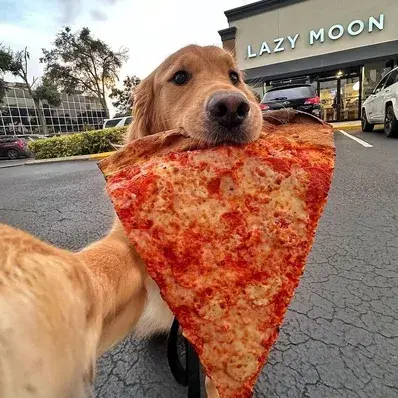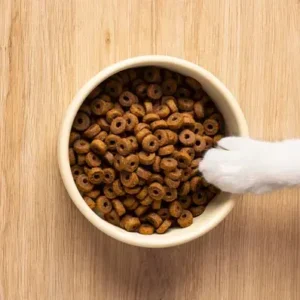How Much to Feed Your Dog Based on Size
Feeding your dog the right amount depends largely on their size, weight, and activity level. General feeding guidelines for small, medium, large, and giant dogs are based on an average caloric content of 350-400 kcal per cup of dry food. Adjust portions based on your dog’s specific needs and consult a veterinarian for personalized recommendations.
How Much to Feed Puppies
Puppy food is more complex since their nutritional needs change as they grow. Puppies require extra calories, protein, and nutrients for development. As they near adulthood, their diet should gradually transition to an adult feeding routine.
- Puppy Feeding Chart
| Weight Range | 1–3 Months | 3–5 Months | 5–7 Months | 7–12 Months |
| Up to 5 lbs | ½–1 cup | ½–¾ cup | ¼–½ cup | ¼–½ cup |
| 6–10 lbs | 1–1½ cups | ¾–1 cup | ½–1 cup | ½–¾ cup |
| 11–20 lbs | 1½–2½ cups | 1–1¾ cups | 1–1½ cups | ¾–1¼ cups |
| 21–40 lbs | 2½–4¼ cups | 1¾–3 cups | 1½–2½ cups | 1¼–2¼ cups |
| 41–60 lbs | 4¼–5¾ cups | 3–4 cups | 2½–3½ cups | 2¼–3 cups |
How Much to Feed Senior Dogs
Senior dogs have different dietary needs as they age. Veterinarians generally classify dog breeds as seniors at the following ages:
- Giant breeds: 7 years– Great Dane, Saint Bernard
- Large breeds: 8 years – Siberian Husky, German Shepherd
- Medium breeds: 10 years– Border Collie, Cocker Spaniel
- Small breeds: 11 years– Shih Tzu, Miniature Schnauzer
- Toy breeds: 12 years– Chihuahua, Pomeranian
Lifestyle and overall health also affect feeding requirements. Many senior dog foods have lower calorie content to maintain a healthy weight as activity levels decrease. Some formulas include joint-supporting ingredients or help manage age-related conditions.
- Senior Dog Feeding Chart
| Weight Range | Feeding Amount Per Day |
| 18–23 lbs | 1–1⅓ cups |
| 24–45 lbs | 1⅓–2¼ cups |
| 46–65 lbs | 2⅓–3 cups |
| 66–85 lbs | 3–3⅔ cups |
| 86–105 lbs | 3¾–4⅓ cups |
| 106–125 lbs | 4⅓–4¾ cups |
| Over 125 lbs | Add ¼ cup per additional 10 lbs |
Feeding guidelines may vary based on your dog’s metabolism, activity level, and specific health conditions, so always consult your vet for personalized recommendations.
How Much to Feed a Healthy Adult Dog
Feeding a healthy adult dog is straightforward since their nutritional needs remain stable unless their lifestyle changes.
The key factor is weight. Use your dog’s body weight per day—not necessarily their current weight—to determine the correct portion. If they are overweight, feed them slightly less; if underweight, feed them more.
- Adult Dog Feeding Chart
| Weight Range | Feeding Amount Per Day |
| 3–12 lbs | ½–1¼ cups |
| 13–20 lbs | 1¼–1⅔ cups |
| 21–35 lbs | 1⅔–2⅓ cups |
| 36–50 lbs | 2⅓–3 cups |
| 51–75 lbs | 3–3¾ cups |
| 76–100 lbs | 4–4⅔ cups |
| Over 100 lbs | 4⅔ cups + ⅓ cup per 10 lbs over 100 lbs |
Wet Food vs. Dry Food: Does It Affect Portion Size?
Choosing between wet and dry dog food isn’t just about preference—it also impacts how much your dog needs to eat.
Here’s how portion sizes vary based on type of food:
- Wet food contains more moisture and fewer calories per cup, so dogs need a larger portion compared to kibble.
- Dry food is calorie-dense, meaning smaller portions may be sufficient.
- Mixed feeding can be a good balance but requires portion adjustments.
Understanding Dog Food Labels & Caloric Needs
Feeding the right amount of food starts with understanding what’s in your dog’s food. Here’s how to read labels and calculate their daily caloric intake.
- Check the feeding guidelines on the packaging.
- Calculate your dog’s daily caloric intake based on weight and activity level.
- Monitor ingredient quality, as higher-quality foods may require smaller portions.
Signs You’re Feeding Too Much or Too Little
Recognizing the signs of overfeeding or underfeeding is essential for maintaining your dog’s health. Here’s how to tell if your pup is getting too much or too little food.
Overfeeding signs:
- Weight gain and obesity
- Frequent begging even after meals
- Loose stools or digestive issues
Underfeeding signs:
- Visible ribs and spine
- Lethargy and lack of energy
- Increased food aggression or scavenging
Adjusting Food Portions for Weight Management
Maintaining your dog’s ideal weight is essential for their overall health and longevity. Adjusting food portions based on their body condition can help achieve a healthy balance.
- For overweight dogs: Reduce portions by 10-20% and increase exercise.
- For underweight dogs: Gradually increase food intake and check for underlying health issues.
- Always adjust portions gradually to avoid digestive upset.
Whether your dog needs to lose or gain weight, gradual adjustments and regular monitoring will ensure they reach and maintain their ideal body condition safely.








